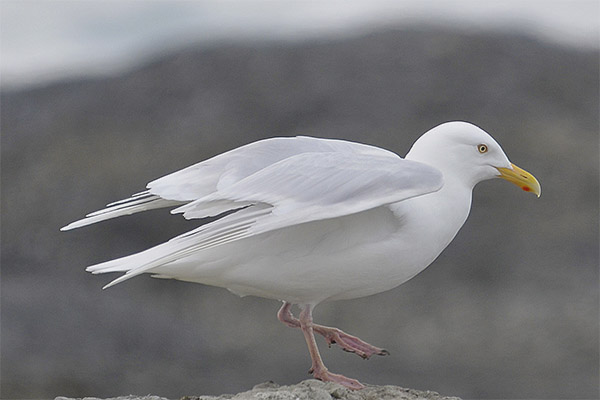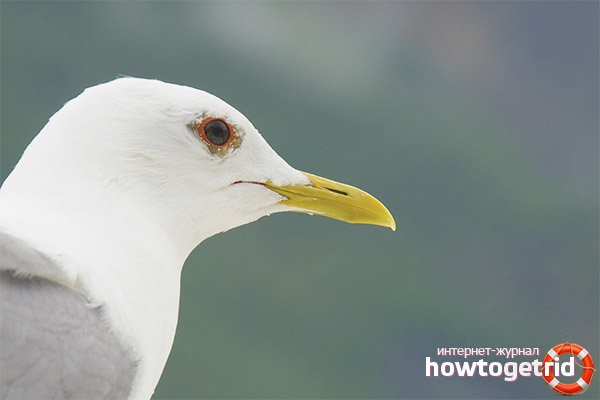The content of the article
A burgomaster is a bird that is large in size and features something resembling a seagull. Otherwise, members of the family are called polar gulls, respectively, they belong to the gull family.
Description
These seagulls are large, they can be compared with marine or silver representatives of the species. They are distinguished by a flat parietal region and a strong beak. The wings are quite long, they can reach 1.5–1.6 m in scope. As for the mass, it varies in the range of 0.9–2.2 kg. The length of the hull ranges from 60-70 cm.
Grown up individuals are famous for their silvery mantle. It is a little lighter than in comparison with silver tea. There is no black patterned pattern on the edges of the wings. On the wing wings is a transverse band. The head is also light, whitish, in winter the plumage in this area is decorated with dazzling areas.
Irises are yellowish and pale. Eyelids of the same shade, but a little darker, they may appear pinkish blotches. On the yellow beak there is a mark of orange tone, and the tip is white. Legs are not bright, pink.
Description of young stock
- Juveniles differ from the adult generation in the color of their plumage. When they get their first winter outfit, they look red or brown with a gray tone. In the area of the mantle motley areas with dark markings are visible.
- Feathers on the wing wings of one tone, it may be brown or grayish. The tips have white markings, no dark areas on the secondary feathers. The tail adapts to the body of the plumage, it is gray with brown.
- There may be spotted patches and specks of dark tone. The iris of the young has a dark shade. The bill is pinkish, with a black mark on the tip. Legs are pinkish, but very light.
- As for the birds that are in their first outfit in the summer, they look very tired. Individuals are practically whitish, there are some specks. When the first winter plumage is replaced by the second, individuals become light, some distinct dark spots appear on the body.The irises of the young calmer brighten, gradually acquiring yellowness.
- The beak in its structure and shade is almost the same as in birds up to one year old, but there are bright areas on its tip. Individuals that have already found their third outfit in winter more or less coincide in hue and other characteristics with adult birds. However, they still have brown spots and a mantle of a light gray tone.
- Immature juveniles are very easy to identify by appearance. If they have not reached the first summer dress, they will have the main distinctive feature of the color of the beak. In the specimens presented, it will have a light pink tint with a bright black finish.
- The polar seagulls on the contrary have a single black beak. Sometimes it can lighten to the base. If you look at such birds from a long distance, the beak of a polar gull may seem completely black.
- In some cases, in gulls and burgomasters, the color of the beak may be similar only in color. Otherwise, you can replace the distinctive features in the form of a different form of the head, beak and general proportions.
- After the burgomaster chicks are born, they look like seagull babies.Only the first differ slightly lighter shade. In addition, they are grayish above with a yellow tinge. Bottom they have a whitish plumage with a yellow throat.
Spread
- It is worth noting that the represented individuals of this species inhabit the Arctic coasts of Eurasia and North America. Often these birds in the winter season try to keep the coastal zone.
- In most cases, this occurs close to nesting sites. In very rare cases, the individuals in question fly into the mainland. Sometimes individuals penetrate to the south of the mainland in the European and central regions of Russia.
Breeding
- The individuals in question can nest alone or in large colonies. In most cases, individuals have their nests on rocks and coastal cliffs. In any case, they must rise above the water.
- Nests, built in such tricky places, can protect the young from the danger of predatory animals. After laying, only a month later the chicks are born.
- In this case, the vysidka future offspring involved both parents. Over time, the female can bring up to 4 eggs.Chicks remain in the nest up to 2 months of age.
Birds prefer to nest in the northern hemisphere and in European countries on the coasts. They are by nature considered migratory, that is, when cooling or due to other circumstances migrate. Today we studied all aspects.
Video: burgomaster (Larus hyperboreus)












To send